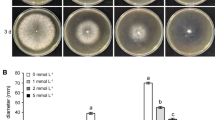Abstract
Trichokonins (TKs) are antimicrobial peptaibols extracted from Trichoderma pseudokoningii strain SMF2. In this paper, it was discovered that TK VI, the main active ingredient of TKs, had a profound inhibitory effect on the growth and sporulation of the moth orchid gray mold, Botrytis cinerea. In addition, TK VI increased the cell membrane permeability of the pathogen. Further investigation of nuclear DNA fragmentation, subcellular structure disintegration, and mitochondrial membrane potential depolarization, as well as the appearance of reactive oxygen species, indicated that TK VI could induce programmed cell death in the necrotrophic pathogenic fungus B. cinerea.
Similar content being viewed by others
References
Strange, R.N. and Scott, P.R., Annu. Rev. Phytopathol., 2005, vol. 43, pp. 83–116.
Benitez, T., Rincon, A.M., Limon, M.C., and Codon, A.C., Int. Microbiol., 2004, vol. 7, no. 4, pp. 249–260.
Harman, G.E., Howell, C.R., Viterbo, A., Chet, I., and Lorito, M., Nat. Rev. Microbiol., 2004, vol. 2, no. 1, pp. 43–56.
Viterbo, A., Harel, M., Horwitz, B., Chet, I., and Mukherjee, P., Appl. Environ. Microbiol., 2005, vol. 71, no. 10, pp. 6241–6246.
Howell, C.R., Plant Dis., 2003, vol. 87, no. 1, pp. 4–10.
Sharman, G.J., Try, A.C., Williams, D.H., Ainsworth, A.M., Beneyto, R., Gibson, T.M., et al., Biochem. J., 1996, vol. 320, no. 3, pp. 723–728.
Wiest, A., Grzegorski, D., Xu, B.W., Goulard, C., Rebuffat, S., Ebbole, D.J., et al., J. Biol. Chem., 2002, vol. 277, no. 23, pp. 20862–20868.
Luo, Y., Zhang, D.D., Dong, X.W., Zhao, P.B., Chen, L.L., Song, X.Y., et al., FEMS Microbiol. Lett., 2010, vol. 313, no. 2, pp. 120–126.
Shi, M., Wang, H.N., Xie, S.T., Luo, Y., Sun, C.Y., Chen, X.L., and Zhang, Y.Z., Mol. Cancer, 2010, vol. 9, no. 3, pp. 26–32.
Shi M., Chen L., Wang, X.W., Zhang, T., Zhao, P.B., Song, X.Y., et al., Microbiology, 2012, vol. 158, no. 1, pp. 166–175.
Song, X.Y., Shen, Q.T., Xie, S.T., Chen, X.L., Sun, C.Y., and Zhang, Y.Z., FEMS Microbiol. Lett., 2006, vol. 260, no. 1, pp. 119–125.
Song, X.Y., Xie, S.T., Chen, X.L., Sun, C.Y., Shi, M., and Zhang, Y.Z., J. Biotechnol., 2007, vol. 131, no. 2, pp. 209–215.
Whitmore, L. and Wallace, B.A., Nucleic Acids Res., 2004, vol. 32, pp. D593–D594.
Li, H.Y., Luo, Y., Zhang, X.S., Shi, W.L., Gong, Z.T., Shi, M., et al., FEMS Microbiol. Lett., 2014, vol. 354, no. 1, pp. 75–82.
Liu, Z.H., Wang, Y., Zhou, C.Y., Kang, G.J., Guo, W.Y., and Pei, X.P., J. Xinxiang Med. Univ., 2014, vol. 31, no. 1, pp. 22–25.
Yang, Z.H. and Dickman, M.B., Mol. Plant Microb. Interact., 1999, vol. 12, no. 5, pp. 430–439.
Cheng, J., Park, T.S., Chio, L.C., Fischl, A.S., and Ye, X.S., Mol. Cell. Biol., 2003, vol. 23, no. 1, pp. 163–177.
Wada, S., Iida, A., Asami, K., Tachikawa, E., and Fujita, T., Biochim. Biophys. Acta, 1997, vol. 1325, no. 2, pp. 209–214.
Hacker, G., Cell Tissue Res., 2000, vol. 301, pp. 5–17.
Eisenberg, T., Buttner, S., Kroemer, G., and Madeo, F., Apoptosis, 2007, vol. 12, no. 5, pp. 1011–1023.
Pereira, C., Silva, R.D., Johansson, L.B., Sousa, M.J., and Corte-Real, M., Biochim. Biophys. Acta, 2008, vol. 1783, no. 7, pp. 1286–1302.
Perrone, G.G., Tan, S.X., and Dawes, I.W., Biochim. Biophys. Acta, 2008, vol. 1783, no. 7, pp. 1354–1368.
Leiter, E., Szappanos, H., Oberparleiter, C., Kaiserer, L., Csernoch, L., Pusztahelyi, T., et al., Antimicrob. Agents Chemother., 2005, vol. 49, no. 6, pp. 2445–2453.
Author information
Authors and Affiliations
Corresponding author
Additional information
The article is published in the original.
Rights and permissions
About this article
Cite this article
Zhao, P., Ren, A., Dong, P. et al. Antimicrobial Peptaibols, Trichokonins, Inhibit Mycelial Growth and Sporulation and Induce Cell Apoptosis in the Pathogenic Fungus Botrytis cinerea. Appl Biochem Microbiol 54, 396–403 (2018). https://doi.org/10.1134/S0003683818040154
Received:
Published:
Issue Date:
DOI: https://doi.org/10.1134/S0003683818040154




